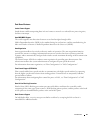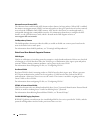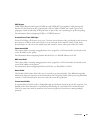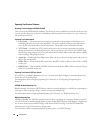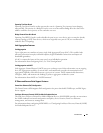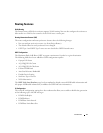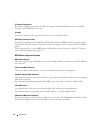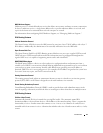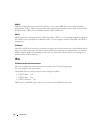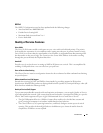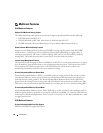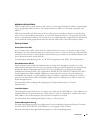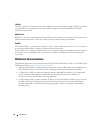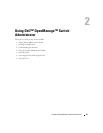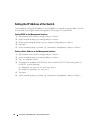
Introduction 33
MAC Multicast Support
Multicast service is a limited broadcast service that allows one-to-many and many-to-many connections.
In Layer 2 multicast services, a single frame addressed to a specific multicast address is received, and
copies of the frame to be transmitted on each relevant port are created.
For information about configuring MAC Multicast Support, see "Managing Multicast Support."
IPv4 Routing Features
Address Resolution Protocol
The PowerConnect 6200 Series uses the ARP protocol to associate a layer 2 MAC address with a layer 3
IPv4 address. Additionally, the administrator can statically add entries in to the ARP table.
Open Shortest Path First
The Open Shortest Path First (OSPF) Routing protocol defines two area types: regular OSPF area and
OSPF stub area. OSPF internal and external route information may be propagated throughout the
regular OSPF area; it is capable of supporting transit traffic and virtual links.
BOOTP/DHCP Relay Agent
The BootP protocol allows a device to solicit and receive configuration data and parameters from a
suitable server. DHCP is an extension to BootP allowing additional setup parameters to be received from
a network server upon system startup. Notably, while BootP stops operating once an IP address is
obtained, DHCP service is an on-going process. For example, the IP address assigned to the system has a
‘lease time’ that may expire, and can be renewed on the fly.
Routing Information Protocol
The routing protocol used within an autonomous Internet system is referred to as an interior gateway
protocol (IGP). RIP is an IGP that is designed to work with moderate-size networks.
Virtual Routing Redundancy Protocol
Virtual Routing Redundancy Protocol (VRRP) is used to provide hosts with redundant routers in the
network topology without any need for the hosts to reconfigure or know that there are multiple routers.
IPv6 Routing Features
IPv6 6 to 4 Auto Tunnels
Automatically formed IPv4 6 to 4 tunnels for carrying IPv6 traffic. The automatic tunnel IPv4
destination address is derived from the 6 to 4 IPv6 address of the tunnel nexthop. There is support the
functionality of a 6 to 4 border router that connects a 6 to 4 site to a 6 to 4 domain. It sends/receives
tunneled traffic from routers in a 6 to 4 domain that includes other 6 to 4 border routers and 6 to 4 relay
routers.



